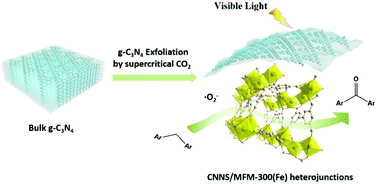Ultra-thin g-C3N4/MFM-300(Fe) heterojunctions for photocatalytic aerobic oxidation of benzylic carbon centers†
Abstract
In situ growth of the metal–organic framework material MFM-300(Fe) on an ultra-thin sheet of graphitic carbon nitride (g-C3N4) has been achieved via exfoliation of bulk carbon nitride using supercritical CO2. The resultant hybrid structure, CNNS/MFM-300(Fe), comprising carbon nitride nanosheets (CNNS) and MFM-300(Fe), shows excellent performance towards photocatalytic aerobic oxidation of benzylic C–H groups at room temperature under visible light. The catalytic activity is significantly improved compared to the parent g-C3N4, MFM-300(Fe) or physical mixtures of both. This facile strategy for preparing heterojunction photocatalysts demonstrates a green pathway for the efficient and economic oxidation of benzylic carbons to produce fine chemicals.

- This article is part of the themed collections: Celebrating Materials Science in the UK and Popular Advances


 Please wait while we load your content...
Please wait while we load your content...